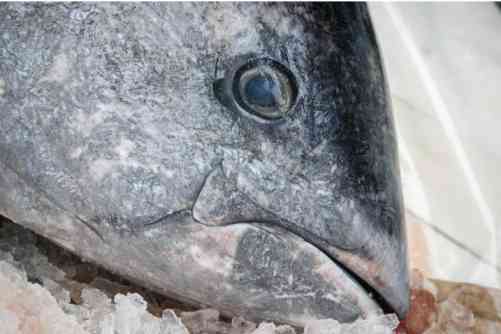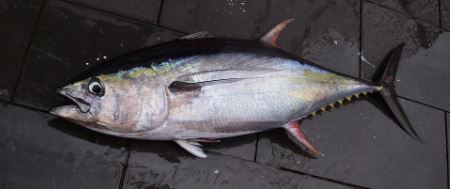Basic information about tuna fish
A tuna is a fish that mostly lives in saltwater. It belongs to the tribe of thunnini which is a subgrouping of the scombridge family. Most of the tunas are found in shouls in the tropical and temperate seas. These fish belongs to the kingdom Animalia, phylum Chordata. Family Scombridae, class Actinopterygii, genus Thunnus, order scombriforms. Tunas grow up to their maximum size and weight of about 4.3 meters (14 feet) and 800 kg (1800 pounds) in adulthood. These fish are used for consumption in the form of food which humans can have a lot of benefits for their health such as, It reduces blood pressure, it improves the immune system, it boosts blood circulation, It reduces depression, and more.

Types of Tuna Fish
There are several types of Tuna Fish available
Bluefin tuna fish (Atlantic bluefin tuna, northern bluefin tuna, or giant bluefin tuna)

Bluefin tuna is the fish species of tuna fish of the family Scombridae. This is the largest species of tuna fish. this species of tuna fish is also called giant bluefin tuna. The scientific name of the bluefin tuna fish is Thunnus.
This is one of the endangered species in all the fish categories. It belongs to the family of Scombridae, Kingdom Animalia, phylum Chordata, genus true tuna. The habitat of the bluefin tuna fish is the North Atlantic ocean. They have the ability to sustain in cold as well as warm temperatures and can frequently dive to depths of 500 to 1000 meters.
Reproduction of the bluefin tuna fish
Bluefin tuna fish reaches the stage of sexual maturity at the age of 3 (years) sometimes it has also been found that they become mature at an age of 4 to 5 years. Average females produce up to 10 million eggs per year. These eggs are buoyant and distributed at a considerable distance by the surface currents.
Bluefin tuna fish food
The adulthood of the bluefin tuna fish usually feeds upon, not only a limited amount of fish but also eat a variety of crustaceans, including crabs, lobsters, crayfish, shrimp, cuttlefish, and even kelp.
Bigeye tuna fish (thunnus obesus)
Bigeye tuna is a species of big-eye tuna that belongs to the wider mackerel family Scombridae. Scientific classification of the fish includes the kingdom Animalia, family Scombridae, phylum Chordata, and order scombriforms.
The scientific name of the fish is Thunnus obesus. This species of tuna weighs around 120kg in adulthood and its size is up to 91-177cm. They are able to capture depths of about 60-280m and capture months were between April and September 2006.
The highest weight of the bigeye tuna fish is recorded up to 392 pounds, 6 ounces. Bigeye tunas are usually found in the open waters of all tropical and temperate oceans, but not in the Mediterranean sea. Bigeye tuna fish is also used for consumption in the form of food which tastes mild and meaty in flavor with a higher content of fat.
Reproduction in bigeye tuna fish
This species gives eggs throughout the year but mostly in summer. They usually spawn two or more times a year. Females release eggs between 3 to 6 million eggs each time they spawn.
Food of bigeye tuna fish
The species generally feed on the top of the food chain preying on fish, crustaceans, and squid. They are also prey for many top predators including sharks, billfish, large tunas, and toothed whales. Teleats cephalopods and crustaceans are the top three major categories consumed by the bigeye tuna fish.
Yellowfin tuna fish (Thunnus albacares)
This species of tuna is larger among the tuna species. The body of the fish is very dark metallic blue, changing to silver on the belly. The anal fin, the second dorsal fin, and as well as the finlets between those fins and the tail is bright yellow in color. The scientific classification of the yellowfin tuna fish is as follows, Kingdom Animalia, phylum Chordata, class Actinopterygii, order scombriforms, family Scombridae, genus Thunnus.

The scientific name of this fish is Thunnus Albacore. This species weighs up to 180 kg (400lb) in adulthood and its size is up to (110-210cm). The lifespan of these fishes is around 5-10 years. This fish is also used for consumption of food that is incredibly nutritious and packed with protein, healthy fats, and vitamins but it shouldn’t be consumed daily due to the containment of a high amount of mercury in it.
The FDA recommends that an adult eats 3-5 ounces (85-140 g) of fish 2-3 times a week to get enough omega-3 fatty acids and nutrients.
Food of yellowfin tuna fish
This species of tuna usually feeds upon the prey including other fishes such as pelagic crustaceans, and squid.
Reproduction of yellowfin tuna fish
This species of tuna in which male spawns throughout the year, mostly in the month of summer. After mating, these fish release the eggs and sperm into the surface water simultaneously for external fertilization. A female can spawn almost daily, releasing millions of eggs each time and ten million eggs per season.
Longfin tuna (Albacore)
The scientific name of Longfin Tuna is THUNNUS ALALUNGA. It is also known as white tuna. The Longfin Tuna or Albacore is one of the smallest tuna species. Weighing only about 80 pounds. The colour of the body of Longfin Tuna is a deep blue with shades of silvery white. The longfin tuna can reach up to 1.4 m (4.6 ft) in length.
Nutrition in Longfin Tuna
Longfin Tuna is an excellent healthy source of protein. It has low in saturated fat & sodium. Longfin Tuna is rich in niacin, vitamin B6, and vitamin B12. It is a good source of selenium, phosphorus, iodine, and magnesium. Longfin Tuna also contains omega-3 fatty acids.
Blackfin Tuna – Thunnus atlanticus (Bermuda tuna, black finned albacore)
Blackfin Tuna are the smallest tuna species in the genus Thunnus, generally growing to a maximum of 100 cm in length and weighing 21 kg. They are commonly found in the western Atlantic, spanning from Massachusetts to Brazil.
Blackfin tuna have fast growth but have a very short life cycle. Blackfin tuna has less commercial value than other tuna because of its smallest size.
Farming of tuna fish
In the Farming process of tuna fish, there is a selection of appropriate land for tuna Farming and the construction of a good pond for raising them. If reared openly then there is a risk, as we know that large fishes are capable of fishing and may eat young ones. There are also some chances of getting out from the region and use for fish farming.
A comfortable pond is required so that they can grow happily and healthier for better meat production. Many of the producers also use to construct a pond with the help of a heavy net in the ocean/sea only for raising fish. In the beginning, very less input is invested depending on the scale of the inceptive unit. The size which is used for commercial tuna farming varies from person to person.
Presence of mercury in tuna fish in 2023: Is this fish safe to eat?
Tuna fish which is one of the most healthy foods to consume, Contains a high amount of mercury nowadays which is harmful to humans because mercury is the most poisonous metal if consumed affecting directly our nervous system which is (Neurotoxic) In nature.
Tuna fish contains a very high amount of mercury As compared to other fishes. Due to this, it is suggested to eat moderately And not on daily basis. The reason behind the containment of mercury in tuna fish is As tuna Long live ocean predators Accumulate a high amount of methylmercury. Shrimp is marked as the fish who contains the least amount of mercury which is 0.012 (ppm) Part per million compared to tuna who has the highest amount of mercury contained Which is 10 times as much Mercury as shrimp Which is 0.118 part per million(ppm).
Canned Albacore tuna and fresh/frozen Tuna steaks Contain 0.353 and 0.384 parts per million mercury(ppm). The only tuna fish which contains a low amount of mercury is Canned light tuna fish. This particular nugget of information is referred to according to USA FDA 1991 to 2010.
Bigeye tuna mercury
Mercury in ppm – 0.689
Mercury (in mcg) per 3 ounces (85 grams) – 58.57
Yellowfin tuna mercury
Mercury in ppm – 0.354
Mercury (in mcg) per 3 ounces (85 grams) – 30.09
Albacore tuna (canned) mercury
Mercury in ppm – 0.350
Mercury (in mcg) per 3 ounces (85 grams) – 29.75
FAQs
Why is bluefin tuna so valuable?
Bluefin tuna is so valuable due to the high demand for excellent fish for sushi and sashimi
Is yellowfin tuna good to eat?
Yes. Yellowfin Tuna is a rich source of protein and some minerals and nutrients like potassium, selenium, zinc, manganese, and vitamin C. It has low calories.
Is bigeye tuna good for eating?
Bigeye tuna is good for health. It is low in saturated fat. It is rich in niacin, vitamins B6 and B12, selenium, and phosphorous.
Can Dogs Eat Raw or Canned Tuna fish?
Comparatively Tuna fish has higher contents of mercury than other types of fish, like Salmon, Catfish and Tilapia hence it can result in mercury poisoning, which can cause severe, or potentially fatal, health complications. Hence it is not recommended.
Can Dogs eat Tuna fish? Is Tuna fish good for dog to eat?
Yes. dogs can eat Tuna.
Can you eat tuna fish while pregnant?
Yes. Canned light tuna fish is a good source of nutrition in pregnancy hence is fine to eat 2 to 3 servings per week.
Is Tuna fish good for cats?
No. Tuna should only be an occasional treat for your cat.
Is Tuna fish good for diabetes?
Since protein in Tuna doesn’t impact blood sugar levels, it doesn’t have a GI ranking and won’t raise blood sugar levels. Hence they can eat Tuna.

4 thoughts on “Tuna fish | Types of Tuna Fish | Farming and presence of mercury in tuna fish in 2023”